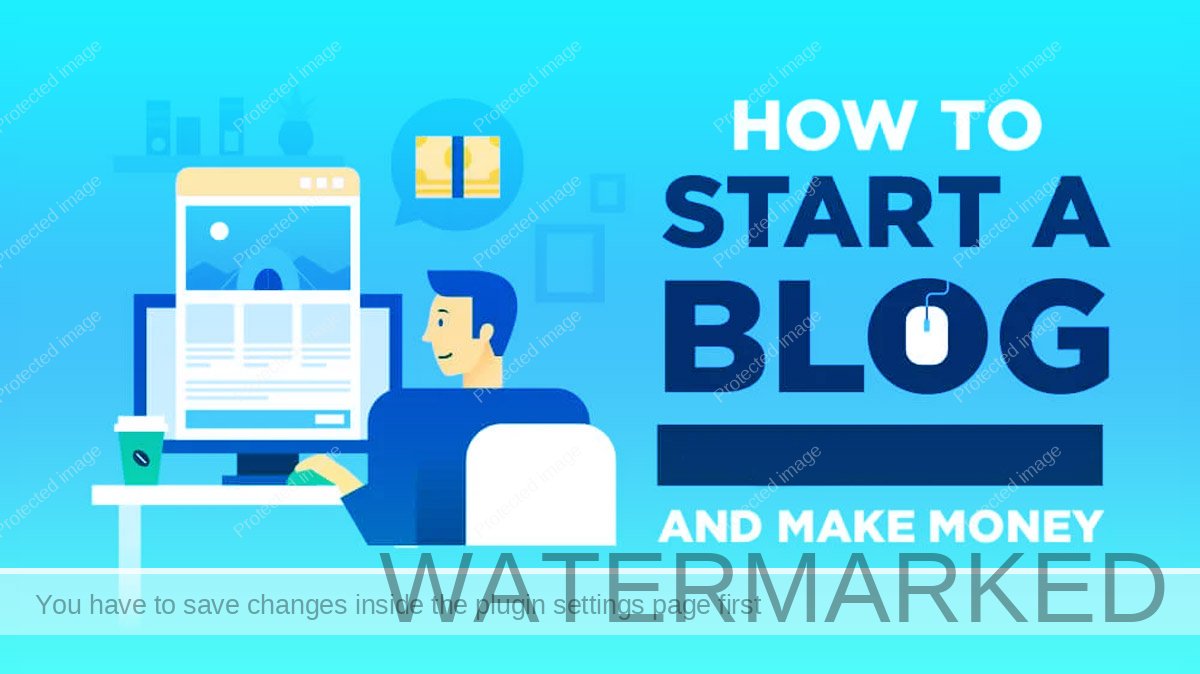How to Start a Blog in 12 Easy Steps: Quickstart Guide for Blogging, Find a Blog Idea, and Monetize Your Blog. All topics are covered in this article.
By answering people’s inquiries, the many blog generates $100000 per month.
Although it may not happen immediately, you can launch a successful blog today.
If you stick with the tried-and-true methods listed below, you can make actual money.
12 Steps to Starting a Blog In 2026
Making money blogging requires more than just writing for pleasure. You will require a strategy for monetization, consistent writing, and a smart approach to SEO to search engine optimization.
Here is all you need to get going:
- Find the Best Hosting
- Find a blog idea
- Find the perfect domain name
- Sign up for Hostinger
- Set up to Install WordPress
- Choose a WordPress theme
- Install WordPress essential plugins
- Set up to Install Google Analytics
- Start to set up your email list
- Choose a blogging cadence
- Grow your audience
- Monetize your blog
Quickstart Guide for Blogging
You can start your blog right now if you already know the name and subject of your blog.
With our deal, get the Premium plan at Hostinger for just $2.79 per month for a full year. For the majority of bloggers searching for affordable, reliable hosting, it’s the ideal place to start.
Considering that the plans start at $2.99 per month with a 48-month commitment, this is an excellent long-term investment.
Get Web hosting, a free SSL, a free domain name, an easy-to-use site builder, and expertly created templates included.
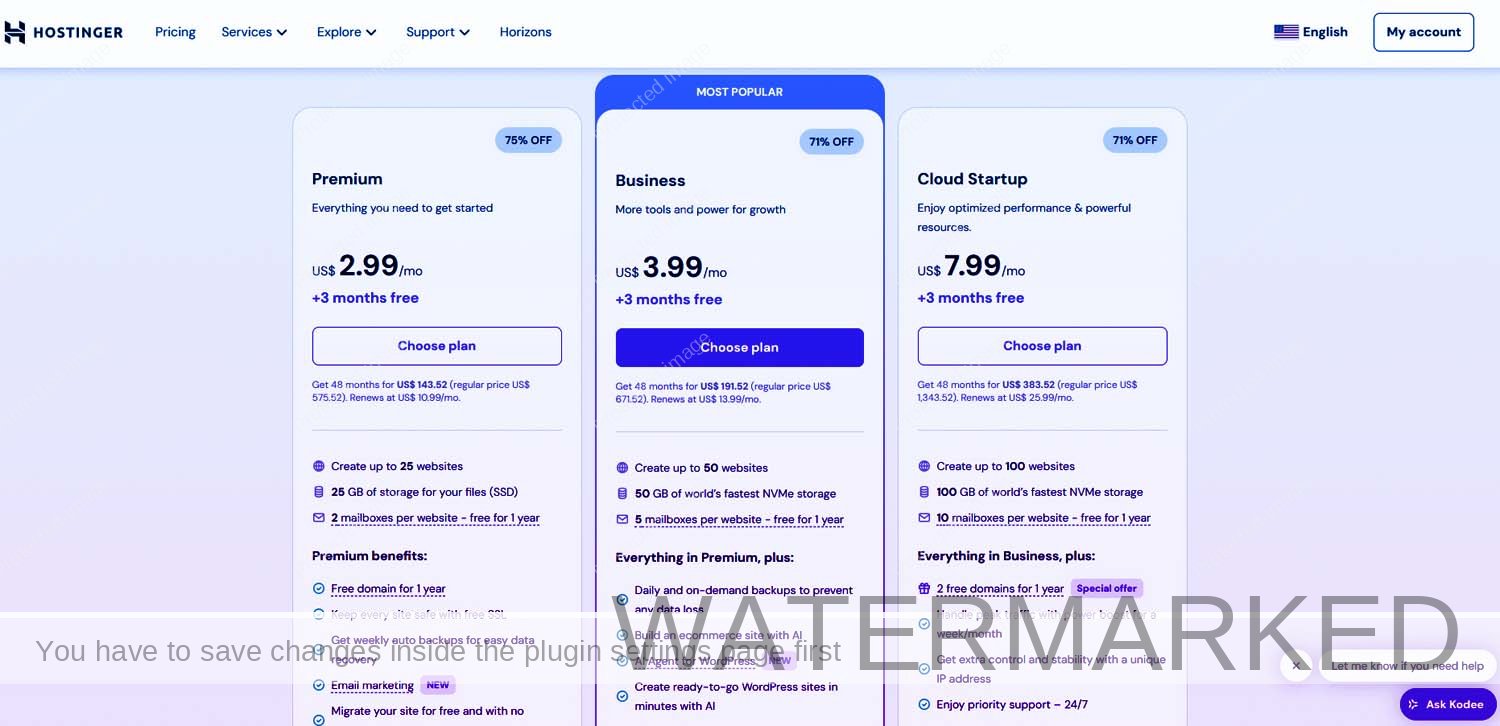
Pricing for Hostinger Premium, Business, Cloud Startup, with the theonlinework.com (T.O.W.) discount applied, along with other options and costs.
Although the 12-month theonlinework.com (T.O.W.) deal has the lowest initial cost, with the additional 3 months free benefit included in the 48-month plan, this plan will net you significant savings.
The registration process is easy to use and intuitive for new users. Hostinger carefully explains each process to you. Here’s a summary:
- Select a web hosting plan by visiting Hostinger.
- After completing the transaction, sign in to your new account.
- Claim your free domain by utilizing the dashboard, or you can do it at a later time.
- Click Setup, then proceed through the detailed wizard.
- After making your selection, select WordPress as your content management system (CMS). Create a new website.
- Choose a theme: You can modify this if you want.
- Select whether to use the suggested plugins or not.
- Complete the setup and go over your selections. That’s all.
You may now access your blog and begin posting stuff immediately.
To ensure you don’t overlook anything important, let’s review the full blog development process from scratch before we delve into revenue.
Step 1: Find the Best Hosting
Hostinger is among the greatest, as I suggest, and I’ll explain which hosting choice is best for you below.
I have written a post on hosting, which you can see. I am giving you its link.
If you feel that you are unable to understand my suggestions properly or find something wrong, you can also comment on them. However, whatever ideas I provide will be valuable and effective for you.
If you want to obtain hosting that maximizes traffic, speed, and performance, you should consider investing in WP Engine.
20$ per month entry-level WP Engine subscription and includes 10 GB SSD as well as 10,000 visitors in a month.
WP Engine: Known for high performance and a 99.9% uptime guarantee, you can use this one.
And when we compare everywhere, Hostinger Hosting always comes out on top. You can check it by signing up; its speed is quite good.
The Premium Shared Hosting plan starts $2.99/month for 25000 visits per month.
You will be able to host up to one hundred websites, manage up to twenty-five thousand visitors every month, and obtain one free domain name for one year. It comes with 100 GB of solid-state storage and an SSL certificate.
Hostinger’s free backup services and 99.9% uptime guarantee.
The suggestions I have given you are all I have used myself. I am providing a list below; you can choose any of these and expect good performance from any of these hosts.
- Hostinger: Overall, the best hosting provider
- DreamHost: Offers shared hosting at the best price.
- SiteGround: suitable for increased performance and security.
- Bluehost: the best option for new WordPress websites.
- Scala Hosting: The greatest alternative to shared hosting.
- HostGator: The best for basic websites.
- WP Engine: The best managed WordPress hosting.
- IONOS: Hosting Provider, eCommerce solutions, Reliable hosting.
With the reliable and comprehensive services provided by all the above companies, launching and managing a website is made simple.
Do you want further specifics? Let’s look at what features make each of these web hosts a great choice.
Step 2: Find a Blog Idea
When you first start your blog, this is one of the most crucial choices you will have to make.
What you write about and, ideally, what you will eventually earn money from depends on your niche. Thankfully, there are people interested in almost every subject.
However, certain niches yield higher profits than others. Finding a topic that both piques your interest and draws a sizable audience is crucial.
Start by responding to these two important questions to refine it:
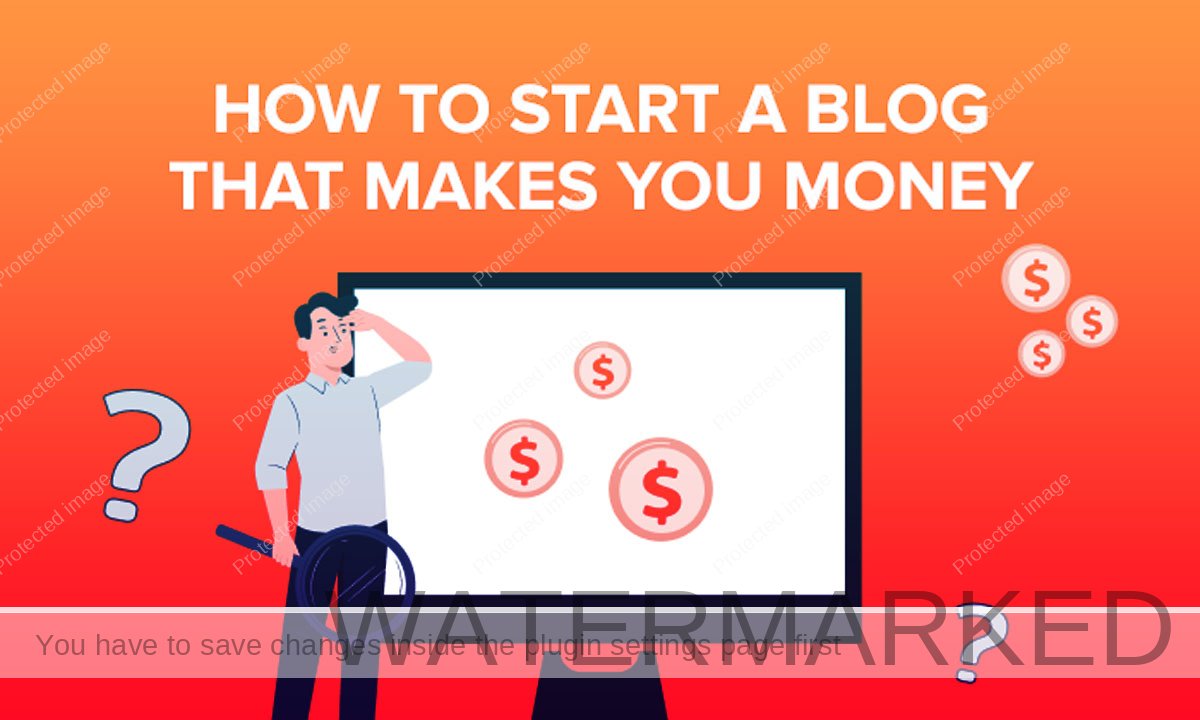
What Interests You?
What excites you? What topic could you discuss for hours on end without growing bored?
Selecting a topic that you won’t become bored with is crucial because your blog will require regular updates over time.
To find your hobbies, try these brainstorming questions:
- Talents: Do you have a natural talent for sketching, writing, or chess?
- Expertise: What fields have you worked in or studied? Consider education, credentials, or prior experience.
- Career: Your work is frequently a fantastic source of content. Professionals with extensive knowledge of their respective fields include developers, marketers, educators, and creatives.
- Hobbies: Do you enjoy playing board games, experimenting with new recipes, or restoring vintage cars? Hobbies are excellent niches.
Note: Make a list of ten to fifteen items that you find interesting. Just write down everything that interests you or that you are familiar with; don’t overthink it.
What are Most People Interested in?
Verifying that people are genuinely seeking the niche online is the second step in selecting a suitable niche. Demand must converge with your passion.
Writing about your dog, for instance, is endearing, but it won’t get many readers. However, a blog focused on pet health, dog food reviews, or dog training advice can attract a large number of readers.
Some related keywords: 1.“puppy training schedule”, 2.”best dog food for allergies”, 3.“how to stop leash pulling”. 4.“My dog” is sweet.
When you initially discovered your interest, consider the questions you had. Probably the same questions are being asked by other people at the same time.
Some evergreen blog categories that consistently yield positive results are as follows:
- Personal finance: Individual financial planning (1. side income, 2. budgeting, 3. saving)
- Health and fitness
- Entrepreneurship and online business
- Fintech and investing
- Time management and productivity
- Real estate
- Job hunting and career advice
- Education or test preparation
- Remote work and freelancing
Pro tip: Examine the volume of actual searches with Google’s Keyword Planner. This might help you find content opportunities and validate your idea.
Note: Examine your list of interests and contrast it with the aforementioned popular categories.
Next, decide on a subject around which you can safely create material for the ensuing six to twelve months.
It’s time to narrow down your topic once you’ve decided on it. A general subject like “business” or “health” is too competitive. Go specific instead, such as “side hustles for teachers” or “fitness for new dads.”
Even combining two interests can result in a blog with a distinctive viewpoint, such as productivity advice for gamers or personal economics for artists.
Step 3: Find the Perfect Domain Name
Choosing a blog name is the next step. At this point, it becomes a little challenging yet fun.
- Bad news: Unfortunately, according to our search, many of the premium domain names have already been taken. It’s no surprise that the web has been around for decades.
- Good news: All you need is a wonderful domain, and we will help you choose the right domain for your blog.
When considering the domain for your blog, keep the following advice in mind:
- Try to keep it to a domain name of a maximum of 14 characters, as short names are better for search results. Short domains are quicker to type and easier to remember.
- Choose one of the most well-known and reliable domain extensions: .com, .org, or .net.
- Make it simple to speak and spell: You don’t want to have to explain your URL each time someone requests it.
- Steer clear of hyphens and digits because they are awkward and difficult to recall. If it’s not necessary, skip them.
- If you are not sure which category you will be in in the long term, consider using your name. It’s adaptable and great for personal branding.
Once you have some ideas, visit Hostinger to see if your domain is accessible.
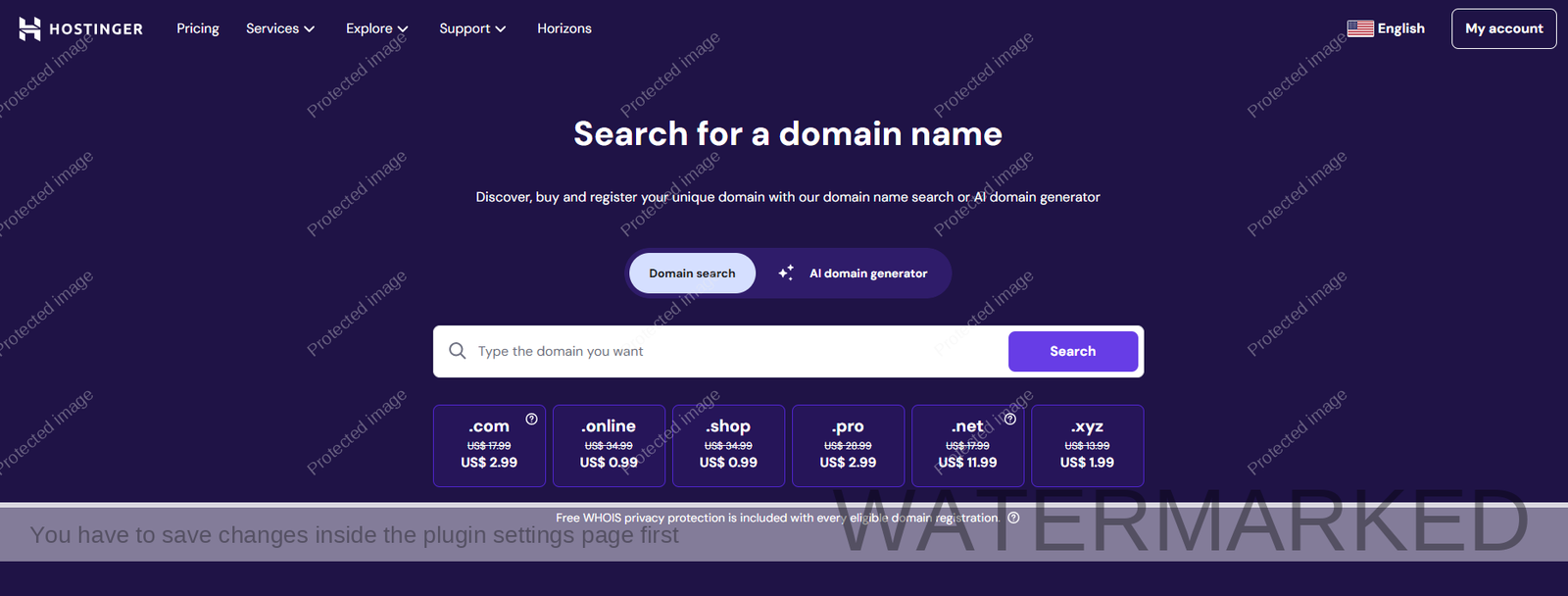
Use the domain search tool offered by Hostinger. Use Hostinger’s domain search engine.
If your domain is already taken, you have a few options:
- Continue coming up with ideas: Utilize synonyms, shorten the name, or include a modifier term such as “blog,” “hq,” or “tips.”
- Buy an existing domain: Some can be sold for thousands of dollars, and the sale can be difficult to negotiate.
- Try an AI name generator: You may use a clever name generator for free on Hostinger’s domain site.
Ideally, a registrar such as Hostinger or Namecheap will offer a reliable domain name for $10 or less.
Do you want to delve further? To assist you in selecting the best service, review our guide to the best domain registrars.
Making Use of Your Name as the Domain
If this is your first blog and you are not yet dedicated to a particular topic, using your name may be a wise choice.
Why? Since it can hurt to switch domains later. Future domain changes frequently require a fresh start in terms of branding, backlinks, and SEO.
For instance, you will require a new domain—and a new beginning—if you begin and then change your focus to blogging about medical financing.
Different domains are adaptable. Doesn’t require a new name to change your blog content. Just delete all the posts that aren’t relevant, and then start writing in your new direction.
However, personal domains have a few drawbacks to be aware of:
- Scalability: It’s harder to expand into a team blog or add more writers under an individual brand.
- Resale value: Personal-branded domains are more difficult to sell if you ever decide to sell your blog.
But these are high-level issues. If you’re just getting started with using your name as a domain, you can proceed without much analysis.
Note: Whatever domain you choose, pick a domain name and commit to it, and work on it.
Make a decision and proceed. Avoid becoming mired in “paralysis by analysis.” Publishing should come first, not finding the ideal domain.
Do you need more assistance? View our in-depth guide on how to buy the right domain name.
Step 4: Sign Up For Hostinger
Need Web hosting, the provider that stores your website and makes it available online, is essential for any blog.
Selecting a trustworthy web host is essential. A quality host maintains your website’s speed, security, and accessibility. A poor one causes technical issues, slow load times, and outages.
After testing dozens of possibilities, we recommend Hostinger for new bloggers. It works better than many more expensive rivals and is inexpensive and simple to use.
If you’re not sure which is the best WordPress hosting provider to use, check out our in-depth guide.
The following factors make Hostinger ideal for beginners:
- Low prices: With the TheOnlineWork discount, monthly prices start at just $2.79.
- A free domain: Most options include annual plans.
- One-click WordPress install: No need for manual setup—just a few clicks and installation finished.
- Fast performance: Even with entry-level plans, there is excellent speed and uptime.
- Dashboard for beginners: Simple to use, even if this is your first time on the site.
To receive the greatest rate, sign up for the Premium plan. With our coupon savings, you can purchase a 1-year hosting plan for just $2.79 every month. At this price, it’s incredible.
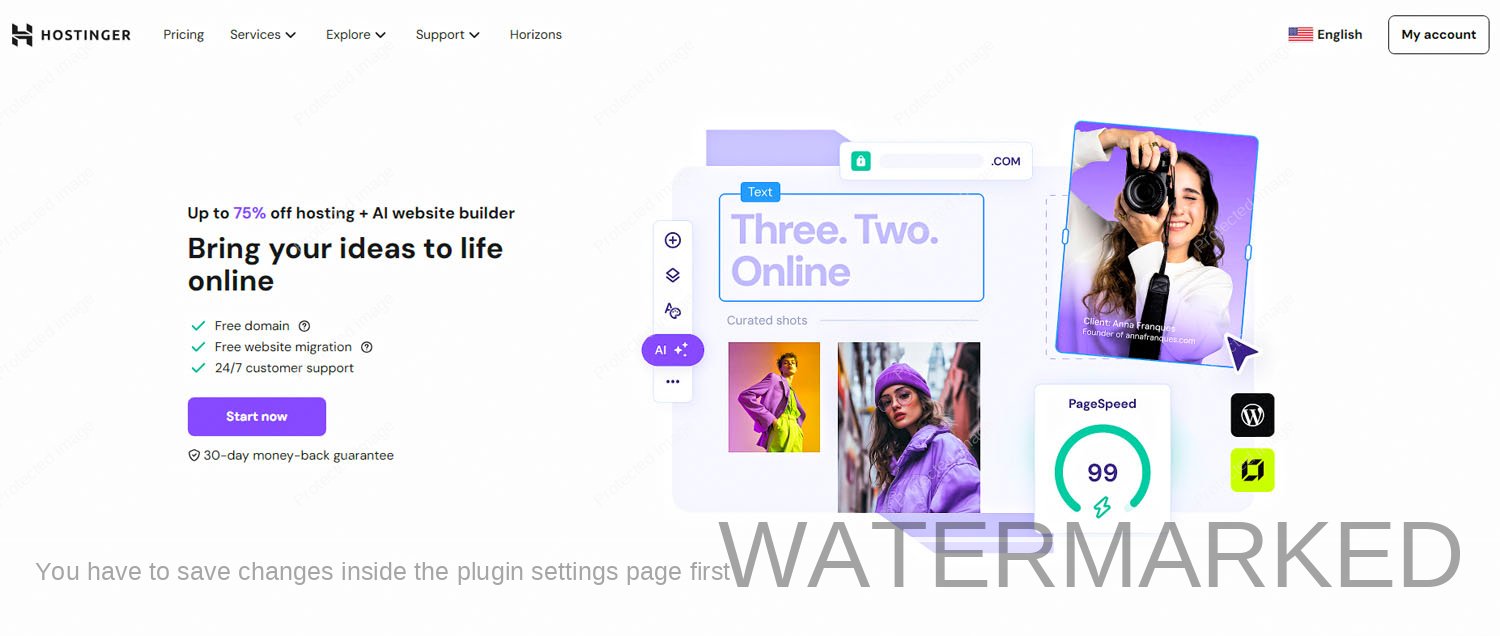
TheOnlineWork.com recommendation on Hostinger’s webpage for Sign Up Premium Plans.
If you want to buy the best user-friendly, affordable, and high-speed hosting, then Hostinger is one of the best hosting providers.
Another advantage? As you grow, Hostinger grows too. You don’t need to switch providers later, as you can easily upgrade to a higher-tier plan when your traffic increases.
Moreover, this plan also comes with a 30-day money-back guarantee if you are not satisfied for any reason. So, there is no risk initially.
Step 5: Set Up to Install WordPress
Any blog must have a content management system (CMS). You will write, edit, and publish your blog entries using this software.
We appreciate WordPress wholeheartedly. It is the best and most adaptable blogging platform, no matter the price.
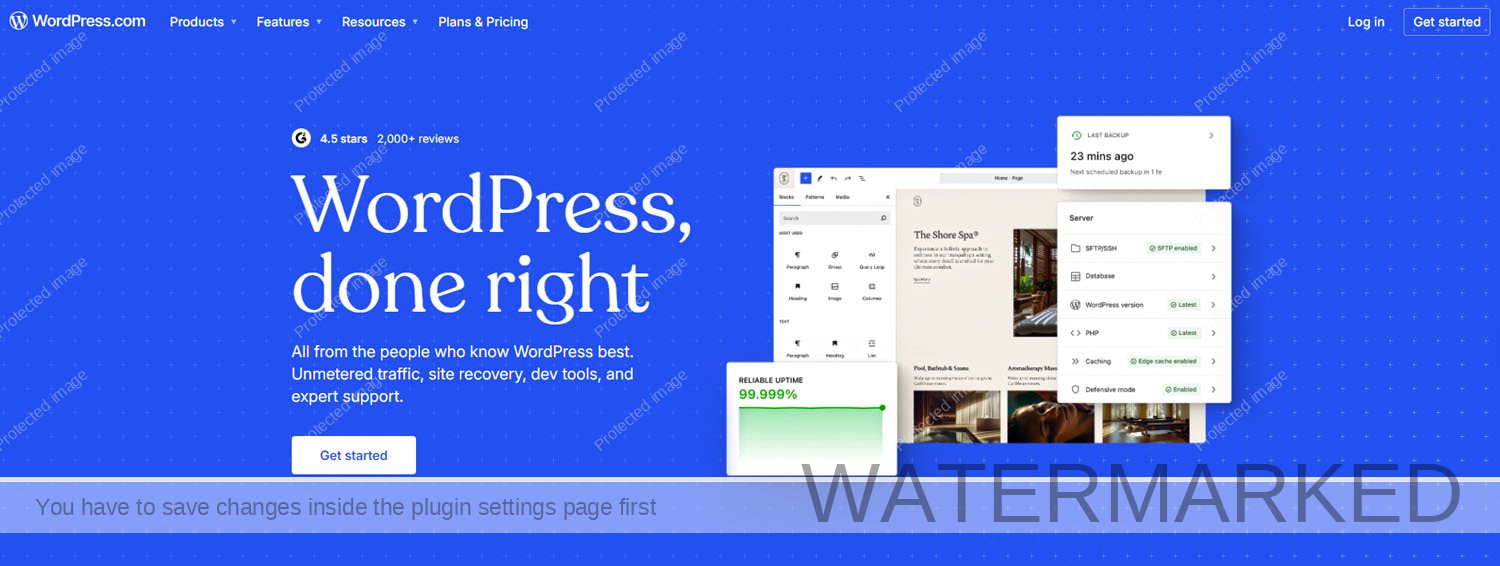
WordPress Websites are powered by More than 40%. For bloggers, it is the most trusted CMS.
Although there are many CMS platforms, such as Squarespace, Blogger, and Wix, none of them compares to WordPress in terms of flexibility, support, and scalability.
The following explains why WordPress is the ideal option:
- Free and open-source: It is completely customisable and costs nothing to use.
- Large ecosystem of plugins and themes: Almost any feature may be added without knowing how to code.
- SEO-friendly: WordPress supports SEO plugins and was developed with search engines in mind.
- Scalable: WordPress expands with you, from a tiny blog to a six-figure website.
Although these offer almost no income opportunities and very little management, platforms like Medium or LinkedIn can help establish authority.
WordPress is the ideal platform for creating a profitable blog.
Installing WordPress on your hosting account is the next step.
Install WordPress automatically on Hostinger’s simple setup wizard. You probably already had WordPress installed if you followed the setup instructions when you signed up.
If not, select the one-click WordPress installation option from your Hostinger dashboard.
Professional tip: The prices of Hostinger’s WordPress plans are comparable to those of their shared hosting plans, but they come with enhanced security and automatic upgrades. It’s wise to select the WordPress plan if you haven’t already.
To begin using WordPress hosting on Hostinger, click here.
Step 6: Choose a WordPress Theme
The biggest advantage of using WordPress is that you can easily change the look of your blog without changing any code.
This is accomplished by using “themes,” which are ready-made design templates that you can quickly apply to give your website a polished appearance.
You can experiment and adjust your design as your website expands because changing themes won’t impact your blog articles or pages.
To start, Hostinger offers a large collection of modern, mobile-friendly WordPress themes.
Don’t overthink; you can change these at any time. Rather, pick a theme that best captures your subject and personality.
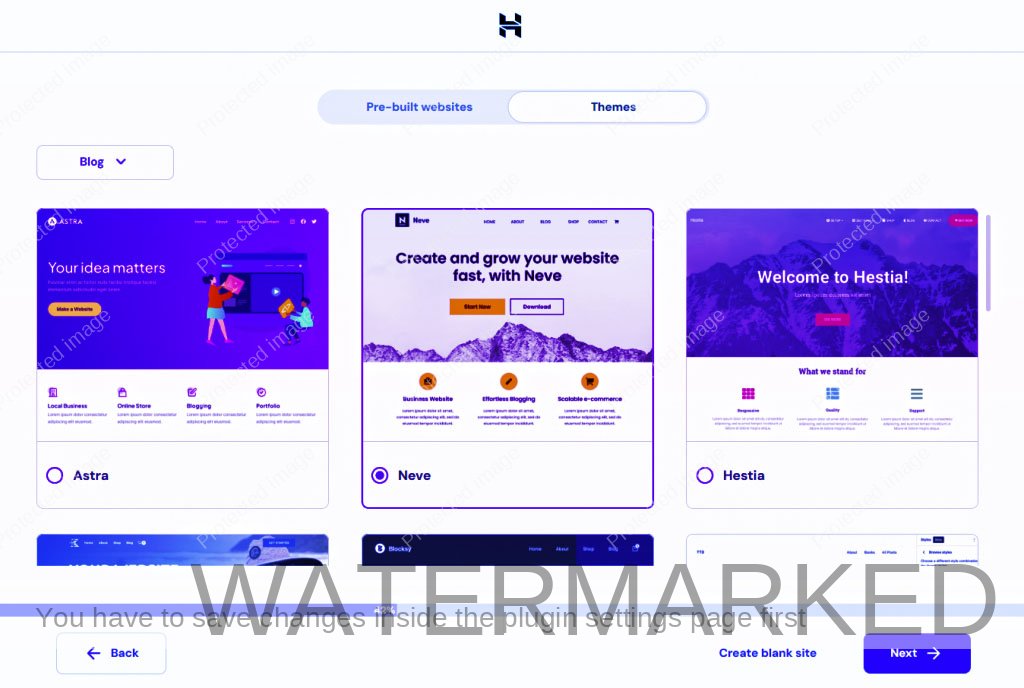
You can use the more than 160 beautiful templates that Hostinger offers immediately.
The WordPress Theme Directory offers thousands of free themes, and third-party developers have even more high-quality themes available.
If you’re looking for some more advanced themes, we recommend StudioPress. They offer well-designed, fast-loading themes that can be easily changed.
These are free if you get a WP Engine hosting plan, which includes them in its plans; most themes cost around $130.
Check out Themeforest, the biggest WordPress theme marketplace with tens of thousands of alternatives at various price points, for even more diversity.
Next Step: Install a WordPress theme.
Go to Appearance after logging into your WordPress dashboard. Select the left sidebar Appearance>Themes, then select Add Themes. You can upload a paid theme or look for free ones from here.
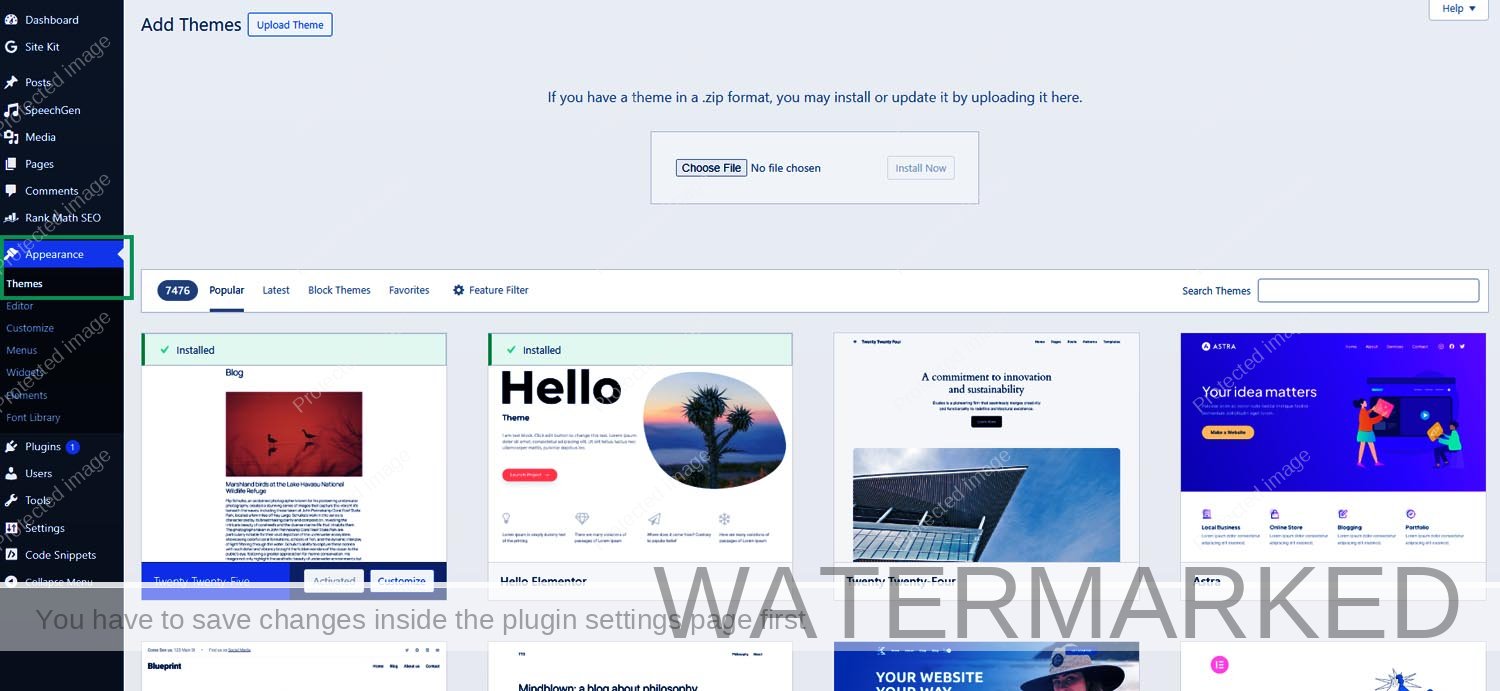
Use the WordPress blog appearance option to choose a theme.
If you purchased a theme, after uploading the .zip file, click Upload theme, select the file, Install, and then select Activate.
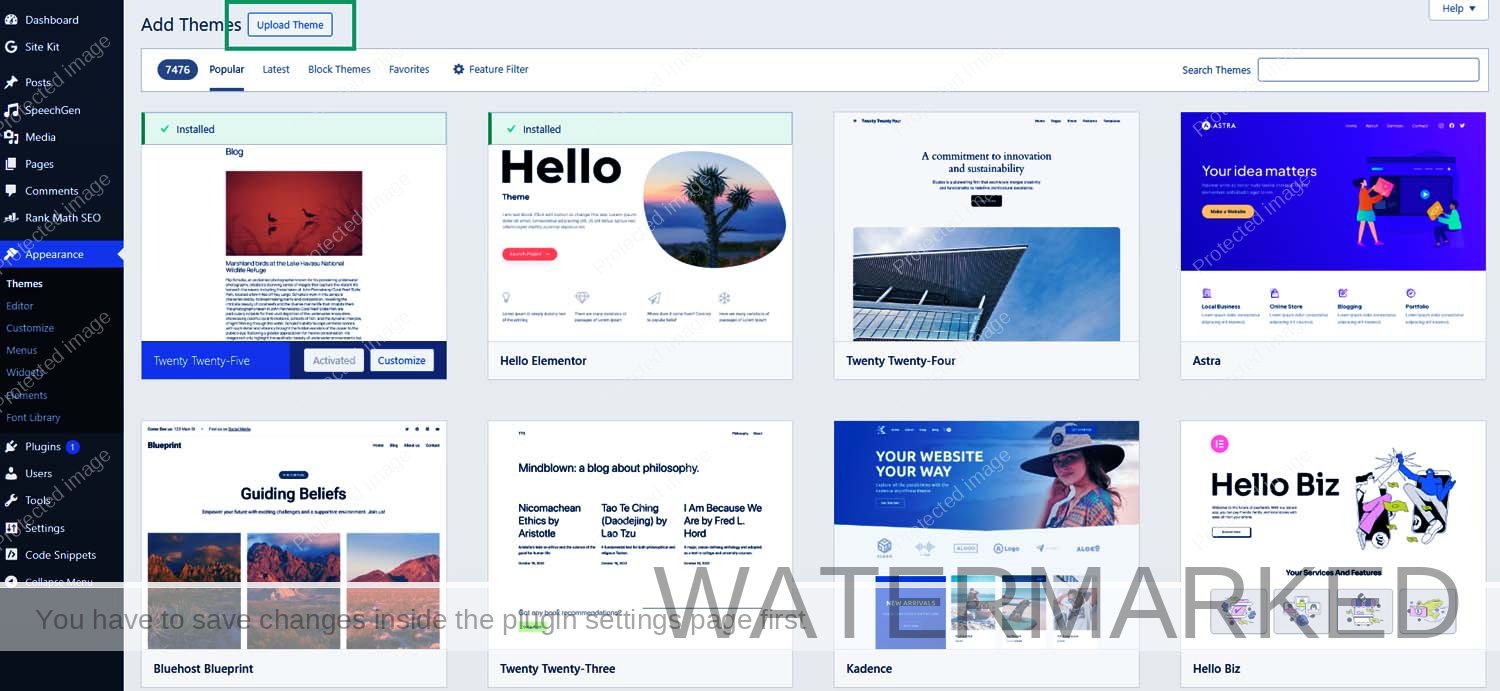
You can customize the theme by clicking on the WordPress dashboard left sidebar tab Appearance > Customize.
You may change your theme under Appearance from here. Personalize. Additionally, you can change themes at any time without losing your material.
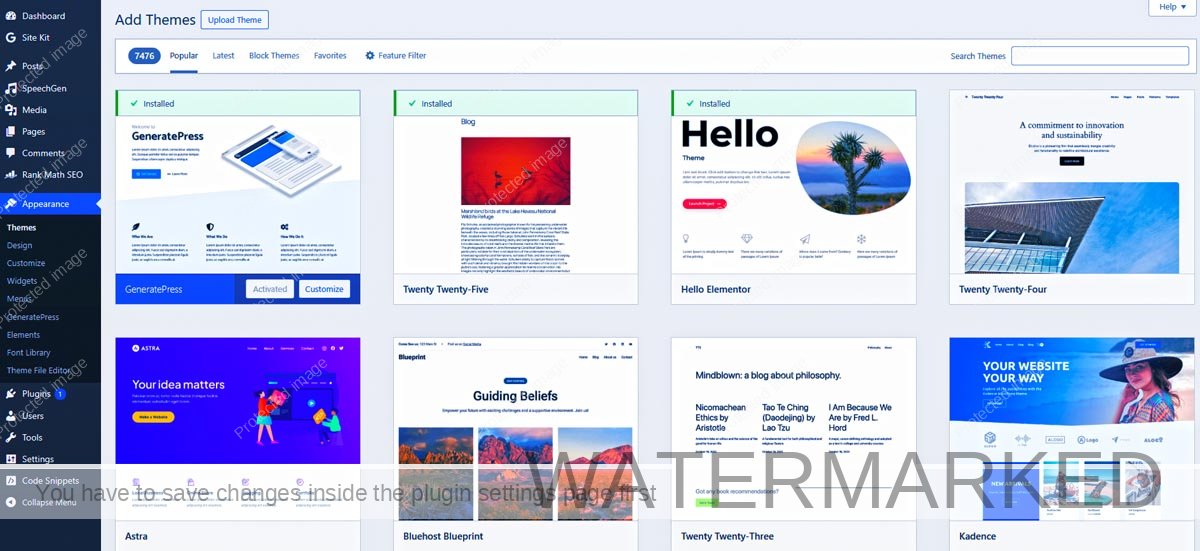
The WordPress dashboard for managing uploaded themes is the Appearance theme.
Especially if you’re starting your blog from scratch, free themes can be a great option to start.
Just make sure the theme you choose is mobile-friendly, well-reviewed, and regularly updated.
Some free themes are outdated or poorly developed, which can affect your website’s security and functionality.
Step 7: Install WordPress Essential Plugins
Using plugins to personalize WordPress to your heart’s content is one of its greatest features.
Plugins are small software applications that provide new features to your blog without any coding knowledge. Consider these as applications for your website.
However, having more plugins doesn’t necessarily mean they are better. Using too many plugins can cause problems, slow down your website, and even compromise its security.
When you first start, we advise sticking with 10-15 high-quality plugins. Select tools that are regularly maintained by their developers and address a particular need.
Note: Only install the plugins that will help you achieve your objectives.
A few essential plugins for novices are as follows:
- WordPress Popular Posts: This feature automatically shows your most popular blog entries at the bottom or footer of your page.
- Yoast SEO: Offers on-page SEO tools that will assist you in optimizing your content for search engines.
- Akismet: It prevents you from doing this by automatically blocking spam comments.
- Contact Form 7: It allows visitors who reach your website through the available contact forms.
- LiteSpeed Cache: This tool increases site loading speed by caching pages.
- Mailchimp for WordPress: This plugin allows you to expand your email list by connecting your website.
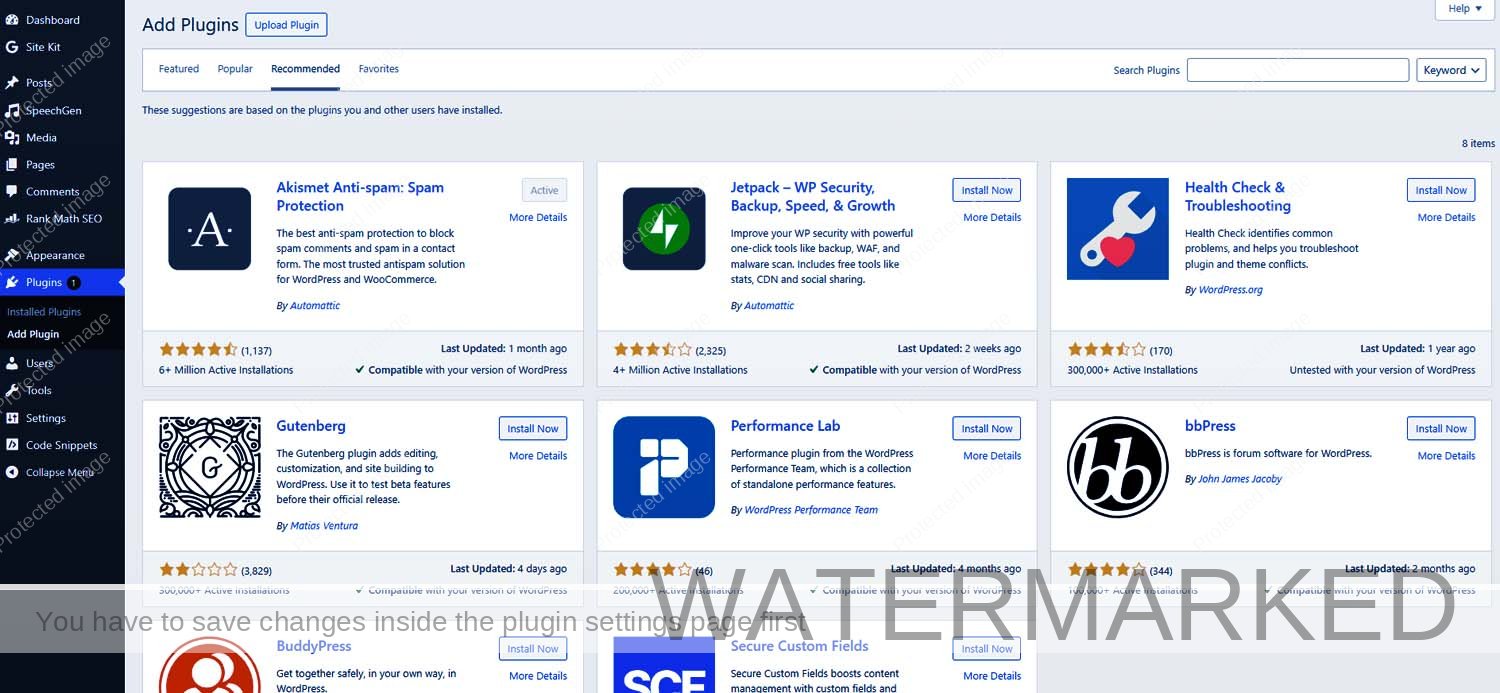
WordPress dashboard on the plugins tab.
By heading to the left sidebar tab Plugins in your WordPress dashboard, you can install plugins.
After selecting Add New, look for the name of the plugin, click Install, and then select Activate.
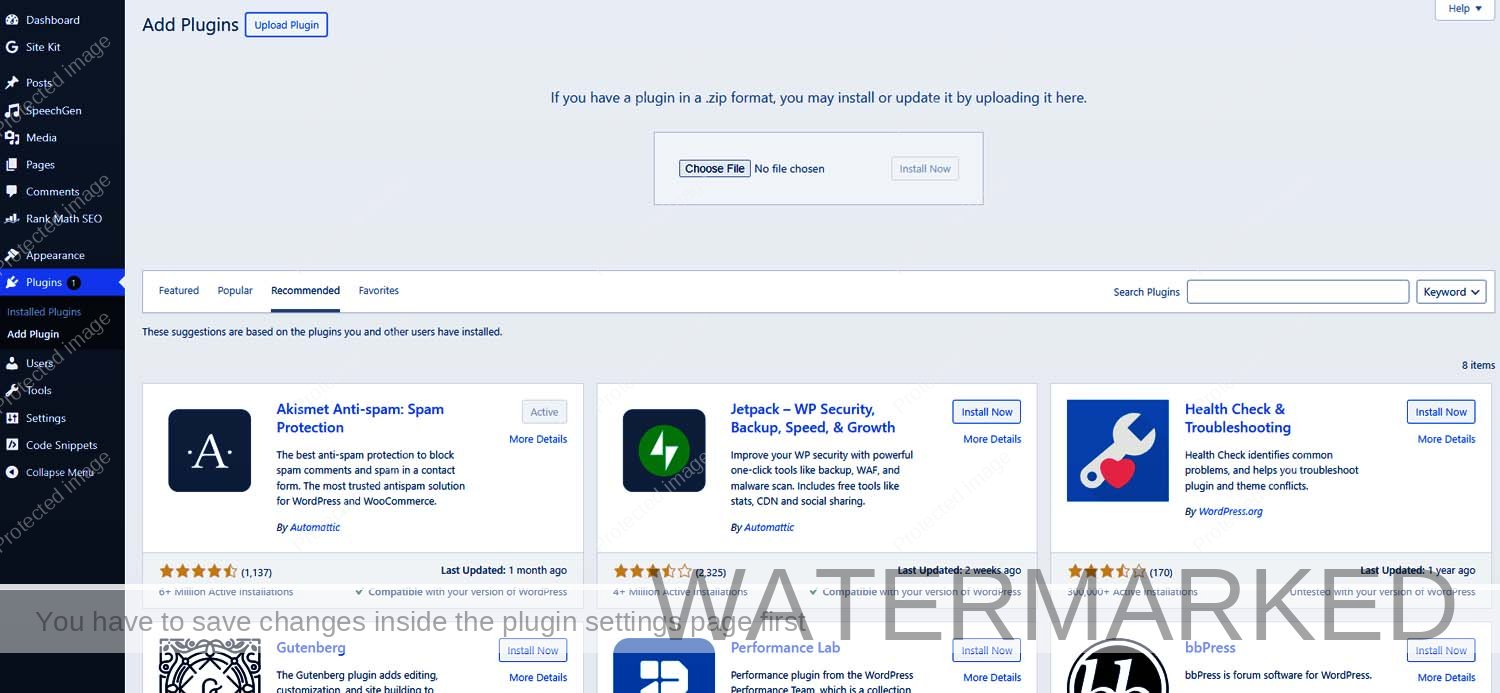
Don’t be tempted to try every great tool out there. If you use fewer and carefully selected plugins, your site will run faster and more smoothly over time.
Step 8: Set Up to Install Google Analytics
You can see how visitors find and use your blog with Google Analytics GA4, a free service. It is essential for identifying what works and what needs improvement.
You can monitor user demographics, popular pages, site traffic, and much more using Google Analytics GA4.
However, don’t worry about all of its sophisticated features just yet. Installing it is the most crucial step for it to begin gathering data.

The easiest way to integrate GA4 and Search Console on WordPress without changing code is to utilize Google’s free Site Kit plugin.
Follow These Steps (quick, no code):
- Go to the Plugins section in the WordPress dashboard left sidebar. Click Plugin > Add New, Search for “Site Kit by Google,” add it, install it, and activate it.
- Launch Site Kit? Open Dashboard, connect Search Console and Analytics, and sign up after signing in using your Google account.
- After browsing your site, check out GA4’s Realtime reports to confirm that data is flowing.
- Enabling Enhanced Measurement in GA4 to automatically monitor file downloads, outgoing clicks, and scrolls is optional.
If you would rather set things up manually, use a header-injection tool or the header settings in your theme to add your GA4 Measurement ID (which begins with “G-“) to the header of your website.
The audience overview dashboard in Google Analytics GA4’s new look.
The two main justifications for setting it up right away are as follows:
- Historical tracking: It will begin gathering data for subsequent usage as soon as you install it.
- Inspiration: Seeing your site receive its first readers is a huge source of inspiration and keeps you going.
Here is a little tutorial on how to install Google Analytics GA4 Measurement ID:
- Open the Google Analytics GA4 Website.
- Click Start Measuring after visiting Google Analytics GA4.
- The Google Analytics website.
- If you don’t already have a Google Account, create one (Create Google Account) and sign in.
- Make an account with Google Analytics GA4.
- Click Next after giving your account a name, such as the name of your blog.
- Here is how to install Google Analytics GA4
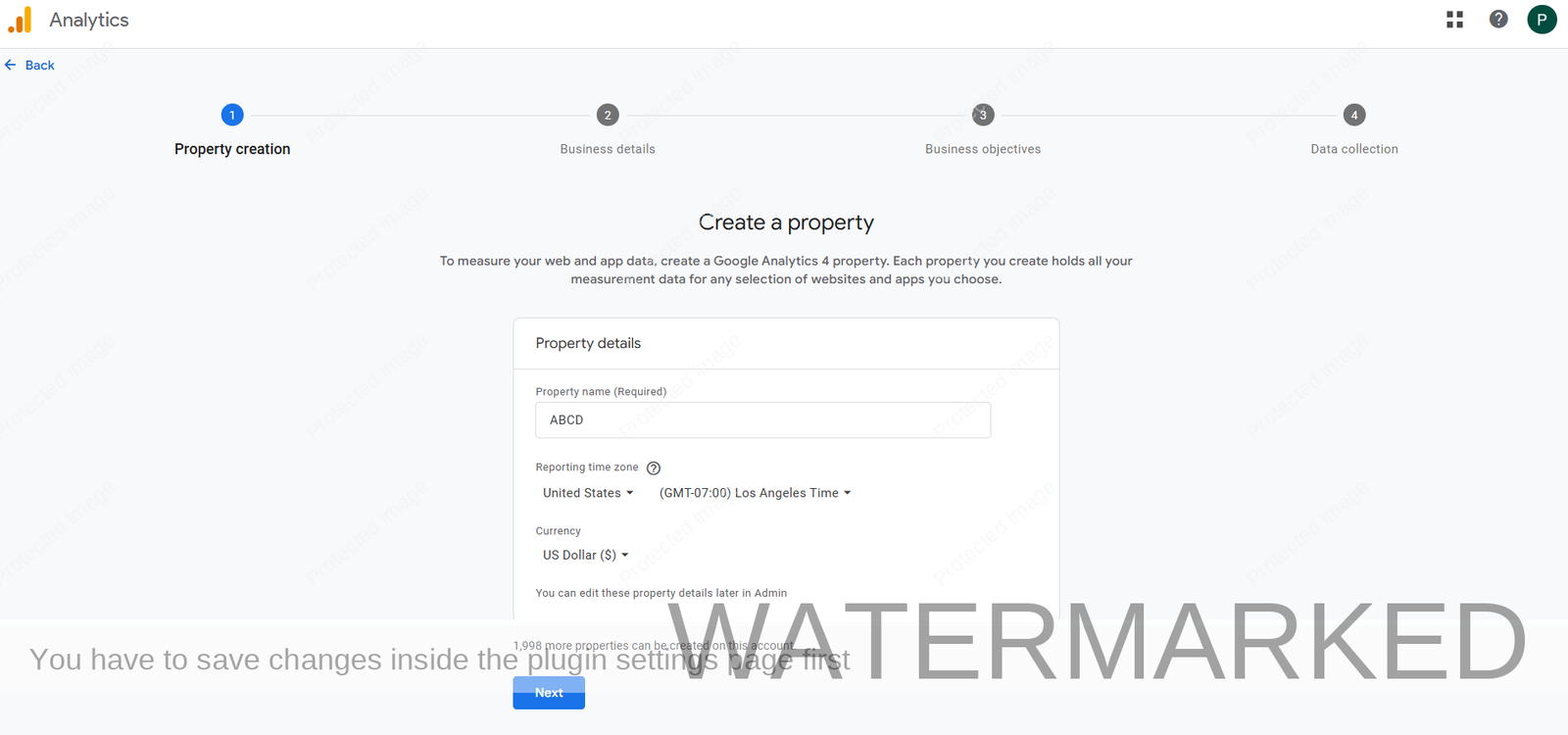
- Decide what you wish to measure.

- Since you’re creating a blog, you can opt for the web instead of other options.
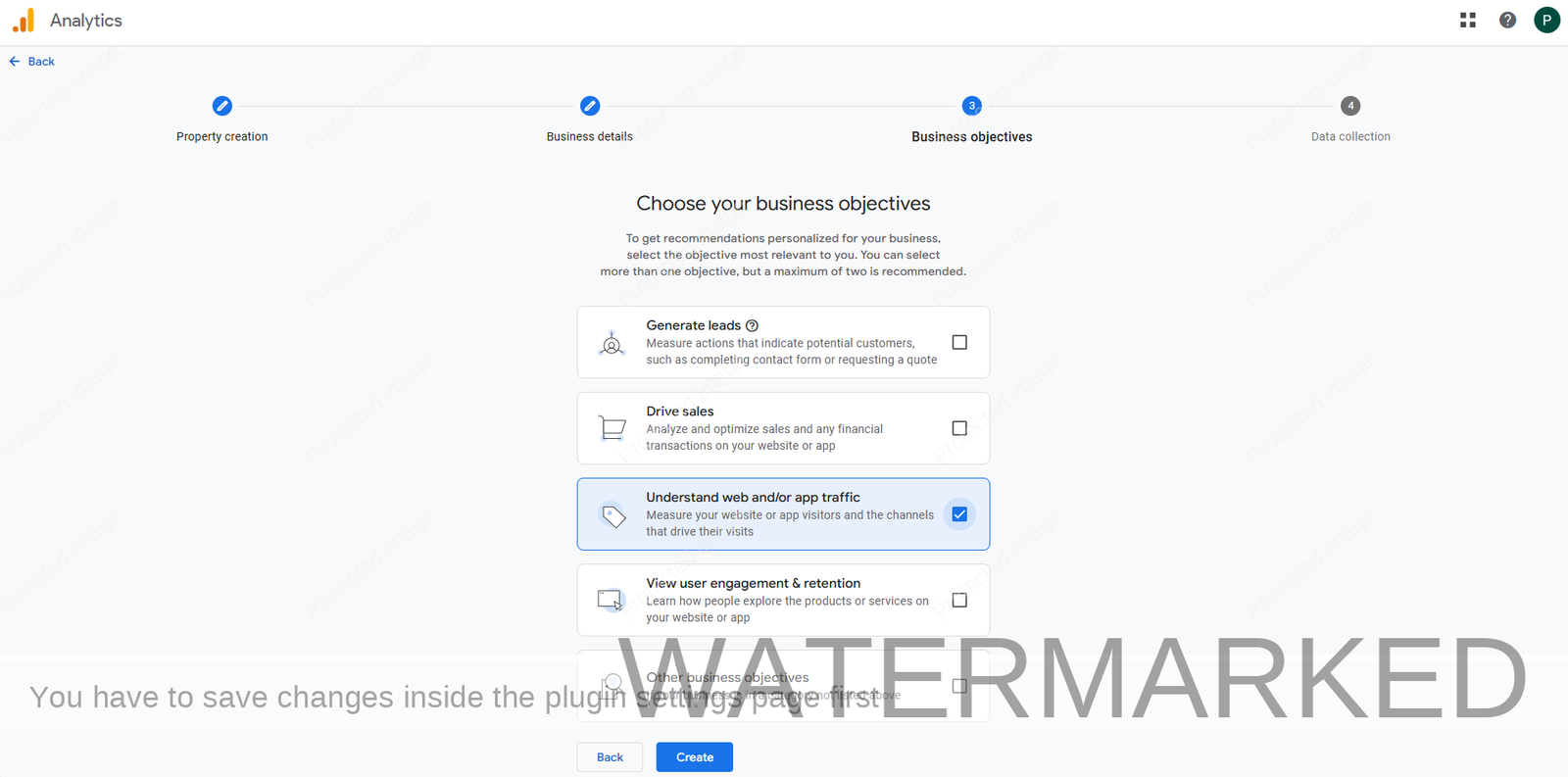
- For example, Google Analytics GA4 is capable of measuring either a website or an application, or both.
- Complete the Property Information.
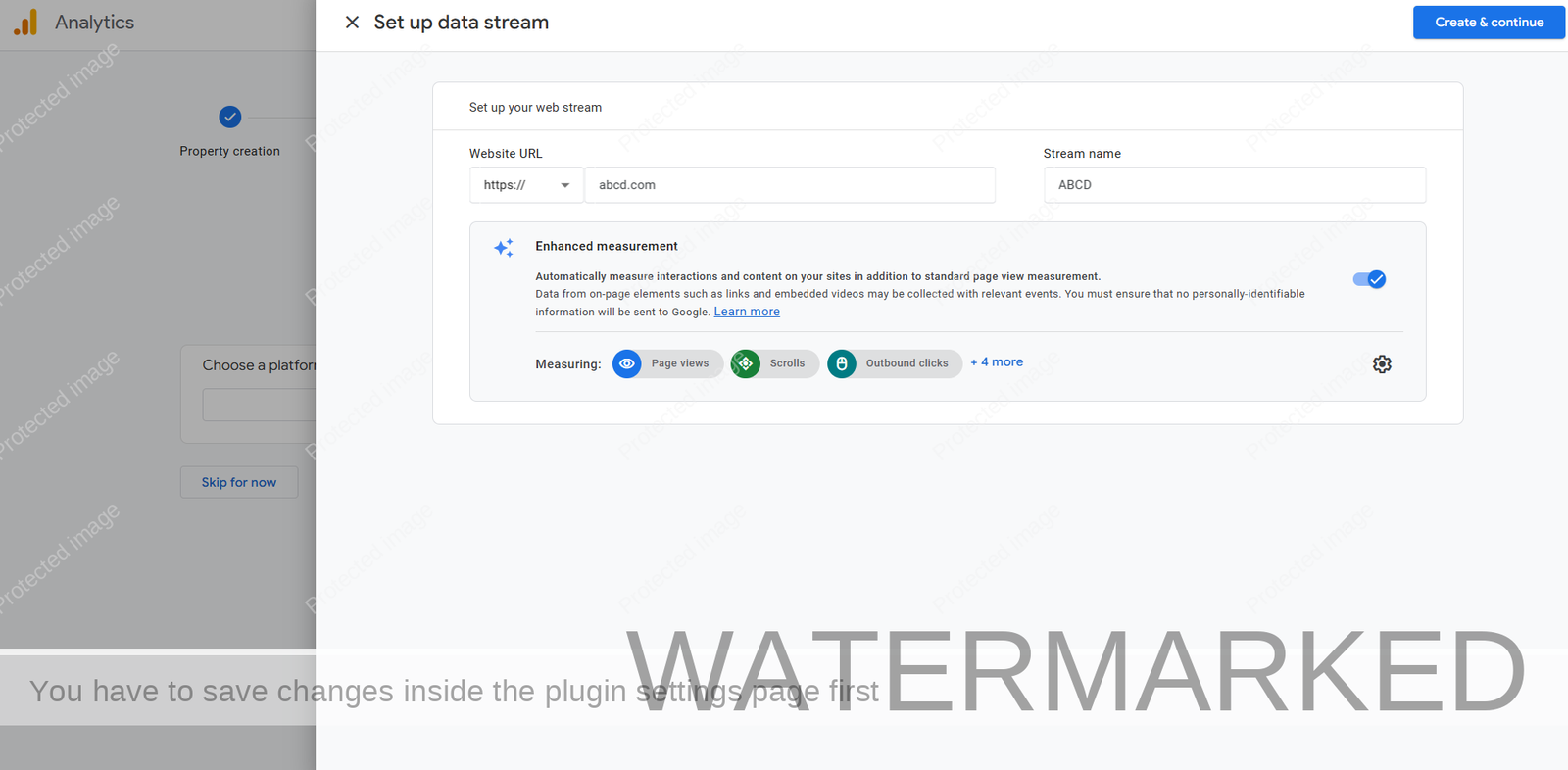
- Enter the time zone, industry, URL, and name of your website. Click Create after that.
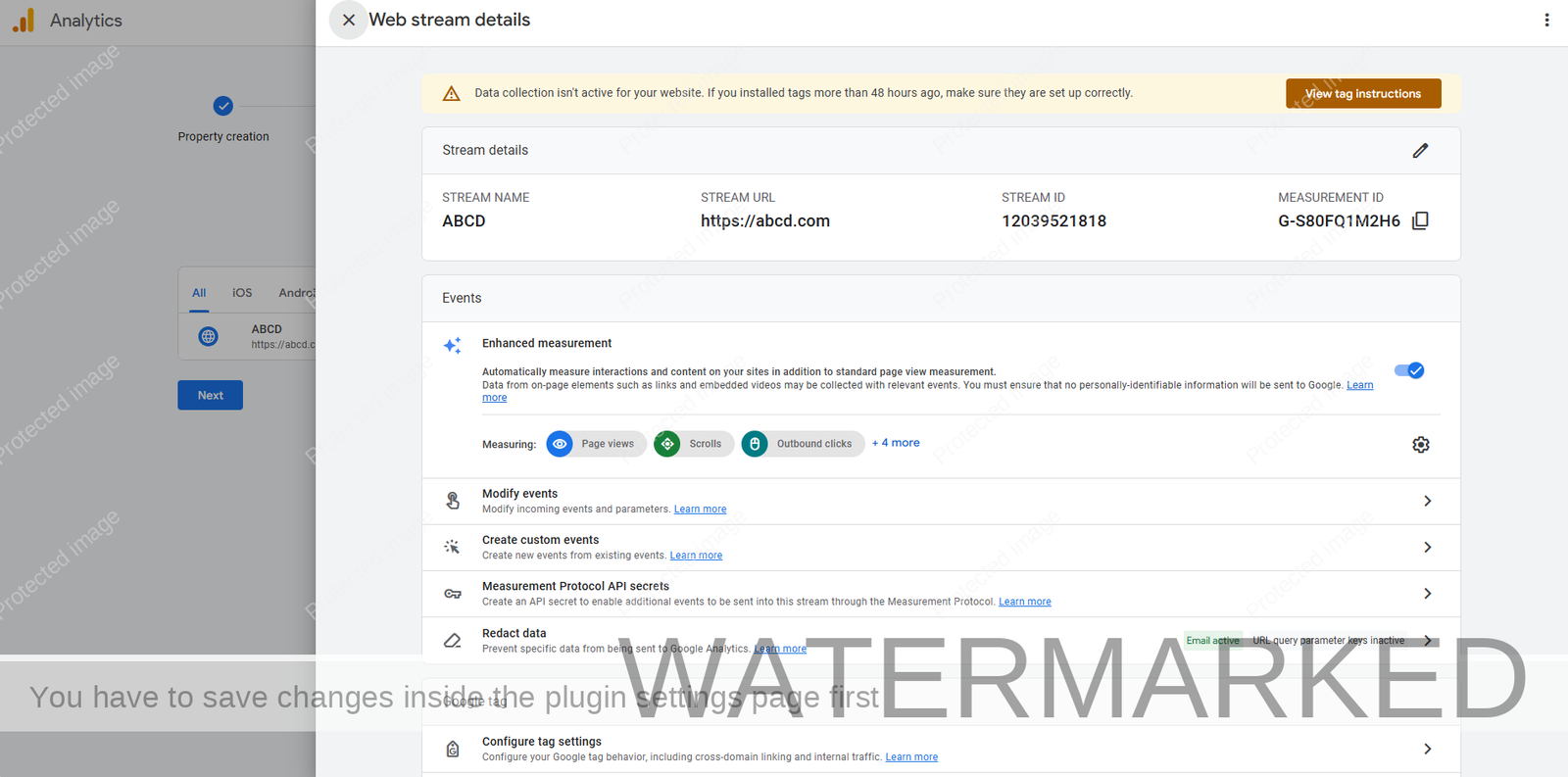
- The tracking code should be copied and pasted onto your website.

A tracking code for JavaScript will be sent to you. Use a plugin like Insert Headers and Footers or the “Header” setting on the majority of WordPress themes to copy and paste it into the header of your website.
What a relief! Beginning right now, Google will start collecting information about the people who visit your website.
More assistance needed? We have a comprehensive guide on how to set up Google Analytics GA4.
Step 9: Start to Set Up Your Email List
Develop and build your email list as soon as possible if you are building a profitable blog. It’s the most dependable method for launching products, reaching readers, and generating consistent traffic.
Keeping in touch with your readers, promoting content, and generating sales on demand are all made possible by your email list. It’s similar to being able to reach your most interested audience directly.
It can be used to promote new blogs, introduce courses, book clients, and sell goods. It all begins with your list, regardless of what you intend to commercialize afterward.
Note: Get email subscribers right now.
The important thing is to start creating and add a simple form to collect emails right away, even if you haven’t decided what you’ll send them yet. That way, when it’s time to grow, you’ll have a list ready.
Constant Contact or another email marketing tool is a good option to start with. It’s inexpensive, easy to use for beginners, and integrates easily with WordPress.
To compare features, you may also look at our guide to the best email marketing tools.
To get started, start with a simple opt-in form in your sidebar or at the bottom of your blog posts. This blog is an example:
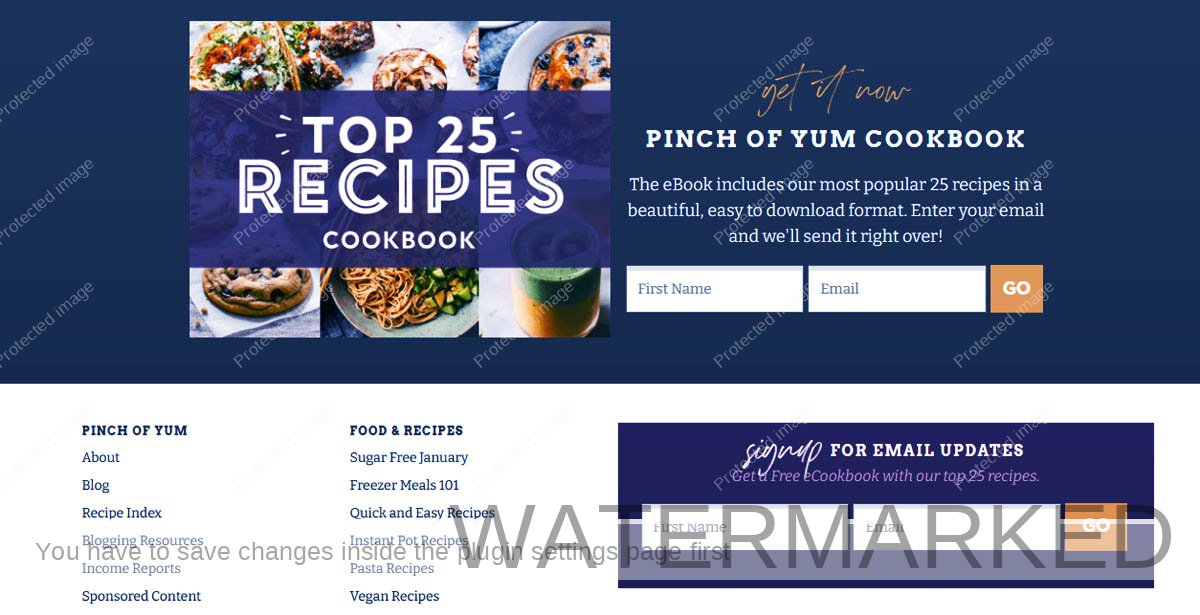
The homepage of the Divalicious Recipes website features an email subscription form in the sidebar.
To entice people to sign up for their email list, Divalicious Recipes provides a useful freebie.
At first, there’s no need for a flashy lead magnet. Just provide updates, helpful advice, or a brief justification for subscribing.
Once you have a few hundred (or thousands) subscribers, your list becomes a significant source of income. Many blogger‘ websites make email their main source of income.
Step 10: Choose a blogging cadence
Blogging is a lengthy game; it’s not about burning out in a week. Consider it a multi-month journey rather than a race. Pacing and consistency are essential for success.
The most successful bloggers follow a routine that they can continue for years. Your cadence as a blogger is that beat.
The following benchmarks can assist you in determining your pace:
- Minimum: At least one weekly post with 1500 words or more. This serves as the starting point for creating genuine momentum.
- Moderate: two to three times a week. With this amount of work, many bloggers develop more quickly.
- Advanced: five to seven postings every week. Usually calls for a team of authors or full-time attention.
- Enterprise: 25+ posts a week for Enterprise. Large content marketing teams (think NerdWallet or HubSpot) do this.
Long-form content remains the most effective. In-depth articles (typically 1500 to 3000+ words) are rewarded by Google, especially when they fully address search queries.
A word of caution, though: don’t sacrifice your readers to write for Google. People-first content is given priority in Google’s July 2026 Helpful Content Update. Write not to manipulate the algorithm but to assist actual people.
Utilize tools to help, not to replace:
- Use AI writing tools: Generate ideas or create outlines, but edit for voice and accuracy yourself every time. AI-generated content should never be mindlessly copied or pasted.
- SEO assistants: Although a high “content score” does not ensure quality or ranking, tools such as Clearscope or Surfer SEO can help you choose your keywords.
- Grammar checker: Grammarly is excellent for finding errors, but save it for your writing personality.
The blog pieces that address the most particular issues for your readers will likely be the most valuable, not the ones that go for the most popular keywords.
Note: Make a weekly commitment to writing one new blog post.
You have ample time to manage everything else (email, design, research, promotion) and produce high-quality content at this rate. Long-term sustainability is another benefit.
This is how a good routine looks:
- Day 1: Write the initial draft, plan your post, and conduct research on the subject.
- Day 2: Edit your draft, add images, format it in WordPress, and then post it.
Quality is the most important factor. Every post needs to strive to outperform any other that is currently ranked for the same subject.
Step 11: Build an Audience and Grow Your Audience
It will fail if no one reads your blog; the blog won’t grow without readers. Consequently, one of your top concerns ought to be building an audience.
This is the most practical and effective target to pursue early on: 1,500 real fans.
Start a business around your blog, and a full-time business in many niches if you have 1,500 active readers.
If you want, you can leave your work to people who read, buy, and share it. Although it’s not simple, it is doable.
Note: Use multiple writers and regularly publish excellent content to grow your follower count and make your site the best resource in your niche.
The essentials for growing your audience are as follows:
- Be reliable: Don’t miss a week. To let your audience know when to expect new information, publish frequently.
- Increase quantity: If possible, increase to two or three posts per week.
- Search your topic: Strive for excellence by looking at the top three Google results for the subject you are writing about. Then inquire, “How can I improve mine? “
- Offer a new perspective: Feel free to talk about things that have been said before, examples, failures, and share your experience. Share your opinion, expertise, or unique perspective.
- Write like a human being: Write in an actionable, conversational, and specific tone so your article sounds. Act as if you were writing to a colleague or close friend.
- Promote interaction by allowing readers to submit comments using a platform like Disqus.
- Participate in relevant communities by joining groups on Facebook, Reddit, Discord channels, LinkedIn, X (previously Twitter), and specialized forums. Build trust, assist others, and share only pertinent information.
- Always ask yourself: “How can I improve this for the reader? “
Growing your audience takes time. Real traction normally takes 12 to 24 months. However, you will succeed if you continue to write and assist others in resolving actual issues.
Fun fact: 77% of internet users read blogs. To build a business, you only need a small portion of them.
You should improve your marketing strategies as your blog gets more established. In our post on the 5 Stages of Blog Growth, we reconstruct it.
Step 12: Make Monetize Your Blog Profitable
It’s time to turn your blog into a business when you’ve increased traffic and gained the audience’s confidence.
Three fundamental monetization tactics work:
- Information Product includes webinars, eBooks, courses, and paid communities.
- Recommending a product and getting paid a percentage of each transaction is known as affiliate marketing.
- Consulting or freelancing: Providing services using your blog to generate leads.
Let’s dissect each one:
The Work of Info Products
The basic formula is as follows:
- Increase blog traffic by attracting qualified search traffic with helpful posts.
- To persuade people to sign up for Build Your Email List, provide a free resource.
- Feed them into a product funnel, such as a webinar or paid course.
- Convert 0.5–1.5% of new subscribers into buyers of $500–$2,500 worth of goods.
The catch? Strong copywriting abilities and a specialization related to relationships, wealth, or status are necessary because those are the three things that people are most likely to spend money on.
How Affiliate Programs Work
Affiliate marketing is simple: You make recommendations to your audience about goods and services, and you get paid when they buy using your link.
Building trust with your audience and promoting only what you genuinely believe in will make this effort more successful.
Focus on high-quality traffic and a strong product fit, as affiliate links tend to generate less revenue for sites with low traffic.
Just don’t forget to include a disclosure, as shown in this Outside Magazine example:

An illustration of affiliate disclosure in a digital article from Outside Magazine.
The FTC requires this straightforward and efficient affiliate disclosure.
How Consulting and Freelancing Works
Use your blog to draw in consultancy or freelancing work if you want to earn money fast. Even with minimal traffic, it’s the quickest way to make money.
Writing informative material in their field of expertise is how many bloggers get clients. With prospective customers who require your services, it increases credibility and confidence.
This strategy often enables people to earn $1,000 to $3,000 per month and quit their jobs in just a few months. Later, you can expand your sources of passive income.
But What About All Those Other Ways to Make Money?
Early on, the majority of alternative tactics aren’t worth your attention. Here’s a summary:
- Books: Great for credibility, but not so good for sales. Use them to establish your brand.
- Events: Unless you already have a sizable audience, there is little chance of success.
- Display ads: Display ads require a large number of visits to generate revenue. Use them only if you get more than 50,000+ sessions per month.
- Speaking engagements can help you gain credibility, but they are unreliable unless you are already well-known.
In short, focus on proven and reliable revenue-generating strategies like affiliate marketing, services, and products.
Don’t waste time on peripheral strategies if they don’t support your primary income strategy.
And above all, don’t stop.
FINAL Note: Maintain consistency. Continue writing, developing, and gaining knowledge from resources such as our extensive collection of blogging guides.
**Frequently Asked Questions About Blog**
Is It Possible to Start a Blog?
Anyone can start a blog today thanks to the abundance of easy-to-use blogging software. All you need to get started is a concept and a website.
Before you get started, choose a blogging platform that will help you meet your long-term goals. While some platforms are great for building connections, others are also better for making money.
After that, you’ll need to do your homework and make sure the platform you select is the best one. Many website builders provide a basic drag-and-drop visual editor, making it easy to create a blog.
This means that creating a personal blog doesn’t require any knowledge of web building. You can enroll in Hostinger’s WordPress hosting plan if you’re a total novice.
This plan includes web hosting, a free domain name, a website builder, and all the tools you need to start blogging right away.
How do bloggers get paid?
In addition to offering freelance and consulting services, bloggers can earn money by selling infoproducts. You can also sell webinars and online courses by including affiliate links in your posts.
These are the three most lucrative ways to monetize your blog, while there are other possibilities as well.
The simplest way to start making money from your blog is through affiliate marketing; all you need to do is register for an affiliate program and create user-friendly content..
To have a database of potential clients at your disposal when you’re ready to introduce new products, as a new blogger, you should also concentrate on expanding your email list.
Check Here: How Do I Start a Blog With No Money?
For example, you may find out what kinds of themes potential readers are interested in by using free SEO tools to aid you with keyword research.
These tools can also give you reports and analytics to see what’s working.
Keep in mind that you will require a web host if you are creating a website for your blog. Prepare well before registering, as some free website-building companies also offer free web hosting.
How Do I Make a Successful Blog?
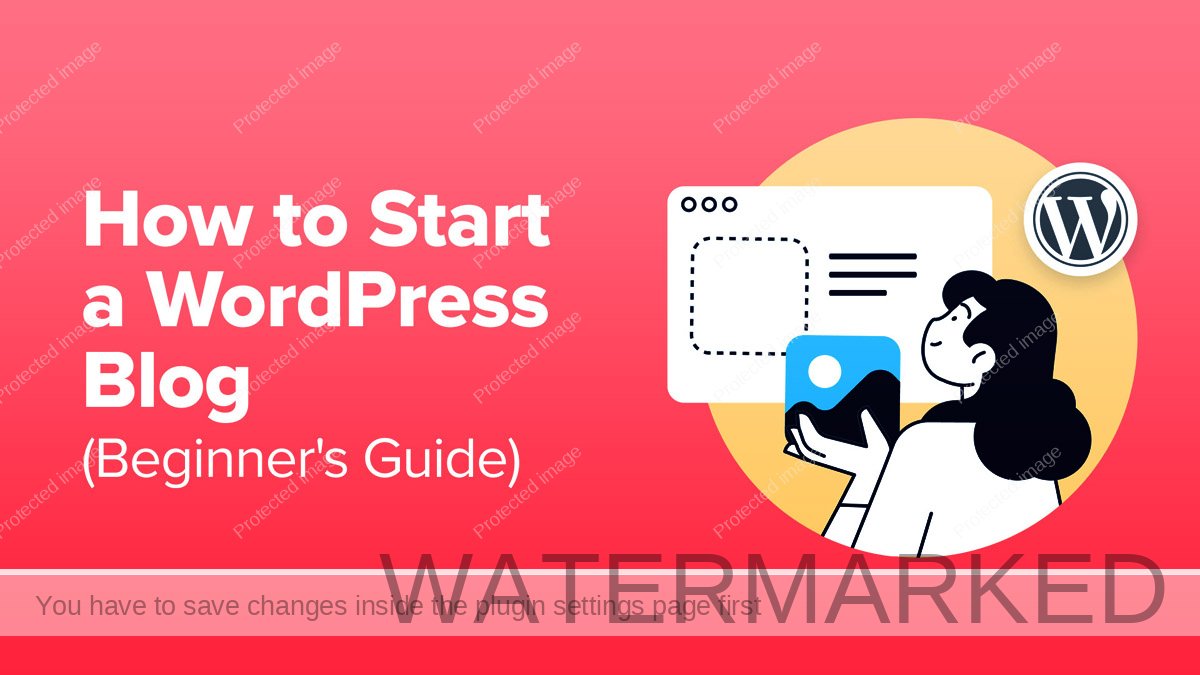
The success of your blog depends on choosing a niche that you are passionate about and truly want to write about.
If your website is updated with high-quality content, we will spend some time learning about SEO best practices.
Write about content that will interest potential readers. It is important to do keyword research on potential blog topics.
Make sure you’re speaking to your audience. Answer messages and comments within a day. By doing this, you may establish relationships with your audience and foster a vibrant community.
How to Write My First Blog Post?
Before writing your first blog post, choose a topic that will interest your target audience. Choose a title for your blog post and organize it. Use headers to separate the content and make the post scannable.
Research your topic if needed, and include citations to your sources. Make sure your writing has a distinct voice and aligns with the reader’s search query.
Before publishing, always proofread the content for grammar, spelling, and other errors. For additional advice and best practices, see our blog writing guide.
How to Start a Blog Without Money?
By using web hosting companies that offer a free name, you can launch a blog for nothing.
Seek out a server that provides free CDNs, SSL certificates, and other security and domain privacy necessities. You can establish a blog using any of the many free WordPress themes available.
Do People Still Read Blogs?
Yes, people still read blogs. Some readers are loyal to a particular blogger and visit daily or weekly to see what topics are being discussed.
However, even those who don’t follow a specific blog still read blogs they come across online.
Blog entries often appear in search engine page results when people search online.
People read blogs to find information, learn new skills, compare products, and more, even though they might not read the entire thing from beginning to end.
What is the Difference Between Blogs and Articles?
There are three main differences between blogs and articles: style, length, and format. Blogs are less formal and might be written in the first person.
Articles are usually more factual and professional, while it is normal for bloggers to express their opinions in posts. Most articles do not do so, except for editorials.
There is considerable flexibility in formatting and style options, and blog postings can be as short or as long as needed. Articles must adhere to the publisher’s rules regarding word count or format.
When discussing online content, the phrases “blog” and “article” are sometimes used interchangeably.

